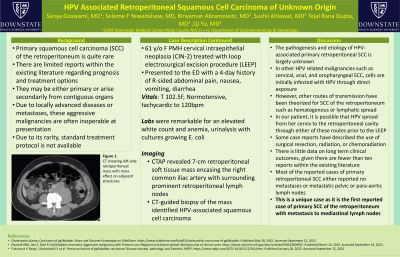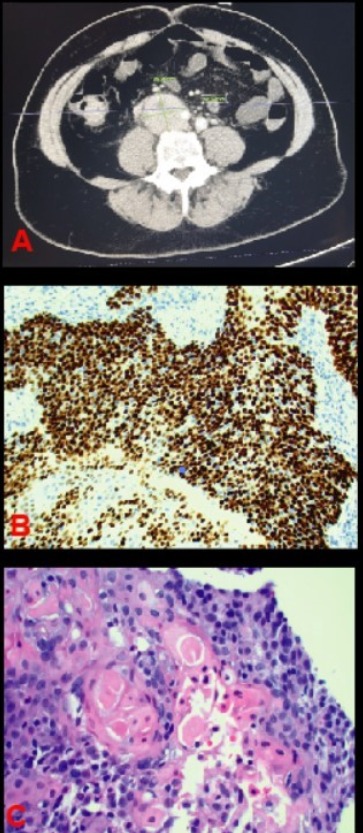Monday Poster Session
Category: General Endoscopy
P2024 - HPV Associated Retroperitoneal Squamous Cell Carcinoma of Unknown Origin: A Case Report
Monday, October 23, 2023
10:30 AM - 4:15 PM PT
Location: Exhibit Hall

Has Audio

Sanya Goswami, MD
SUNY Downstate Health Sciences University
Brooklyn, NY
Presenting Author(s)
Selome F. Yewedalsew, MD1, Binyamin R. Abramowitz, MD1, Sanya Goswami, MD1, Sushil Ahlawat, MD1, Tejal Rana. Gupta, MD1, Qi Yu, MD, MPH2
1SUNY Downstate Health Sciences University, Brooklyn, NY; 2SUNY Downstate Health Sciences University/NYCHHC Kings County Hospital, Brooklyn, NY
Introduction: Primary squamous cell carcinoma (SCC) of the retroperitoneum is quite rare. As there are very few reports within the existing literature, information regarding prognosis and treatment options is largely unknown. We present a unique case of HPV-associated primary SCC of the retroperitoneum with subcarinal lymph node metastasis.
Case Description/Methods: A 61-year-old female with a history of cervical intraepithelial neoplasia (CIN-2) treated with loop electrosurgical excision procedure (LEEP), presented to the ED with a 4 day history of right-sided abdominal pain, nausea, vomiting, and diarrhea. On presentation, the patient was normotensive, tachycardic to 120 bpm with a temperature of 102.5 °F. Laboratory studies revealed a WBC of 15.1 K/uL, Hb 10.7 g/dL, and a positive urinalysis with cultures growing E. coli. CT abdomen and pelvis revealed a 7 cm retroperitoneal soft tissue mass encasing the right common iliac artery with surrounding prominent retroperitoneal lymph nodes and CT-guided biopsy of the mass identified HPV-associated squamous cell carcinoma. Immunohistochemistry stains of the mass were positive for p40, CK5/6, and P16. PET/CT identified mediastinal lymphadenopathy. Further imaging as well as endoscopic evaluation failed to identify any potential primary source of malignancy. Endoscopic ultrasound-guided fine needle aspiration biopsy of a subcarinal lymph node revealed metastatic SCC.
Discussion: The pathogenesis and etiology of HPV-associated primary retroperitoneal SCC are largely unknown. In other HPV-related malignancies such as cervical, anal, and oropharyngeal SCC, cells are initially infected with HPV through direct exposure. However, other routes of transmission have been theorized for SCC of the retroperitoneum such as hematogenous or lymphatic spread. In our patient, it is possible that HPV spread from her cervix to the retroperitoneal cavity through either of these routes prior to the LEEP. In regard to treatment, case reports have described the use of surgical resection, radiation, or chemoradiation, but there is little data on long-term clinical outcomes, as there are less than ten reports of this malignancy within the existing literature. Most of the reported cases of primary retroperitoneal SCC either reported no metastases or metastatic pelvic or para-aortic lymph nodes. This is a very unique case as it represents the first reported case of primary SCC of the retroperitoneum with metastasis to mediastinal lymph nodes.

Disclosures:
Selome F. Yewedalsew, MD1, Binyamin R. Abramowitz, MD1, Sanya Goswami, MD1, Sushil Ahlawat, MD1, Tejal Rana. Gupta, MD1, Qi Yu, MD, MPH2. P2024 - HPV Associated Retroperitoneal Squamous Cell Carcinoma of Unknown Origin: A Case Report, ACG 2023 Annual Scientific Meeting Abstracts. Vancouver, BC, Canada: American College of Gastroenterology.
1SUNY Downstate Health Sciences University, Brooklyn, NY; 2SUNY Downstate Health Sciences University/NYCHHC Kings County Hospital, Brooklyn, NY
Introduction: Primary squamous cell carcinoma (SCC) of the retroperitoneum is quite rare. As there are very few reports within the existing literature, information regarding prognosis and treatment options is largely unknown. We present a unique case of HPV-associated primary SCC of the retroperitoneum with subcarinal lymph node metastasis.
Case Description/Methods: A 61-year-old female with a history of cervical intraepithelial neoplasia (CIN-2) treated with loop electrosurgical excision procedure (LEEP), presented to the ED with a 4 day history of right-sided abdominal pain, nausea, vomiting, and diarrhea. On presentation, the patient was normotensive, tachycardic to 120 bpm with a temperature of 102.5 °F. Laboratory studies revealed a WBC of 15.1 K/uL, Hb 10.7 g/dL, and a positive urinalysis with cultures growing E. coli. CT abdomen and pelvis revealed a 7 cm retroperitoneal soft tissue mass encasing the right common iliac artery with surrounding prominent retroperitoneal lymph nodes and CT-guided biopsy of the mass identified HPV-associated squamous cell carcinoma. Immunohistochemistry stains of the mass were positive for p40, CK5/6, and P16. PET/CT identified mediastinal lymphadenopathy. Further imaging as well as endoscopic evaluation failed to identify any potential primary source of malignancy. Endoscopic ultrasound-guided fine needle aspiration biopsy of a subcarinal lymph node revealed metastatic SCC.
Discussion: The pathogenesis and etiology of HPV-associated primary retroperitoneal SCC are largely unknown. In other HPV-related malignancies such as cervical, anal, and oropharyngeal SCC, cells are initially infected with HPV through direct exposure. However, other routes of transmission have been theorized for SCC of the retroperitoneum such as hematogenous or lymphatic spread. In our patient, it is possible that HPV spread from her cervix to the retroperitoneal cavity through either of these routes prior to the LEEP. In regard to treatment, case reports have described the use of surgical resection, radiation, or chemoradiation, but there is little data on long-term clinical outcomes, as there are less than ten reports of this malignancy within the existing literature. Most of the reported cases of primary retroperitoneal SCC either reported no metastases or metastatic pelvic or para-aortic lymph nodes. This is a very unique case as it represents the first reported case of primary SCC of the retroperitoneum with metastasis to mediastinal lymph nodes.

Figure: Figure 1 Legend
A. Axial CT scan image of the retroperitoneal mass
B. P40 stain of the mass showing squamous cell
C. P16 stain of the mass showing keratin pearls, with enlarged hyperchromatic nuclei with coarse chromatin and inconspicuous nucleoli.
A. Axial CT scan image of the retroperitoneal mass
B. P40 stain of the mass showing squamous cell
C. P16 stain of the mass showing keratin pearls, with enlarged hyperchromatic nuclei with coarse chromatin and inconspicuous nucleoli.
Disclosures:
Selome Yewedalsew indicated no relevant financial relationships.
Binyamin Abramowitz indicated no relevant financial relationships.
Sanya Goswami indicated no relevant financial relationships.
Sushil Ahlawat indicated no relevant financial relationships.
Tejal Gupta indicated no relevant financial relationships.
Qi Yu indicated no relevant financial relationships.
Selome F. Yewedalsew, MD1, Binyamin R. Abramowitz, MD1, Sanya Goswami, MD1, Sushil Ahlawat, MD1, Tejal Rana. Gupta, MD1, Qi Yu, MD, MPH2. P2024 - HPV Associated Retroperitoneal Squamous Cell Carcinoma of Unknown Origin: A Case Report, ACG 2023 Annual Scientific Meeting Abstracts. Vancouver, BC, Canada: American College of Gastroenterology.
